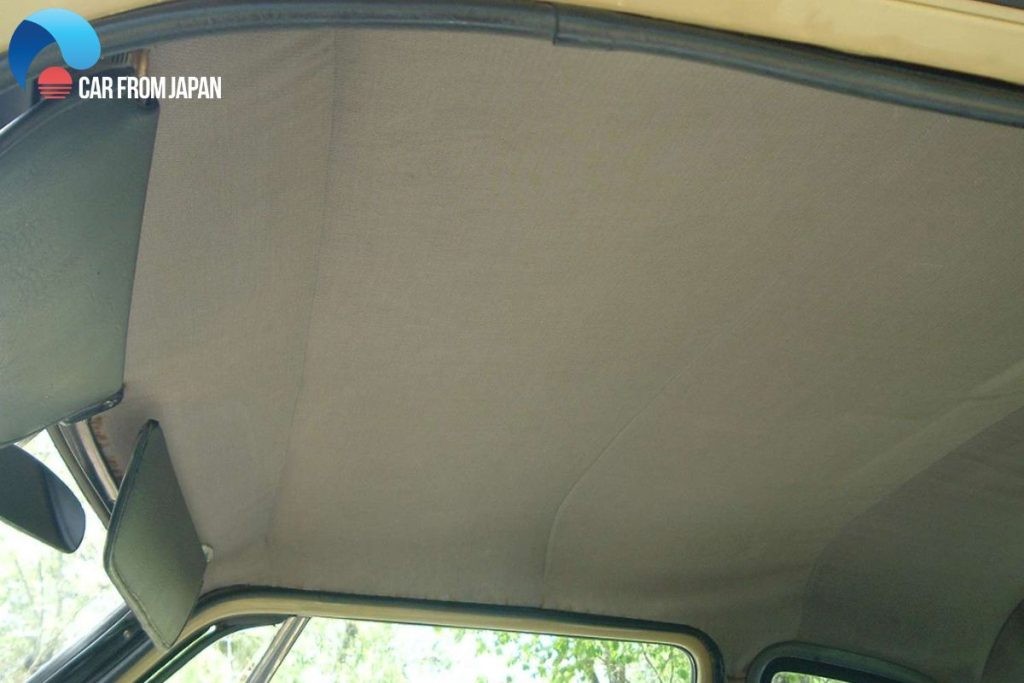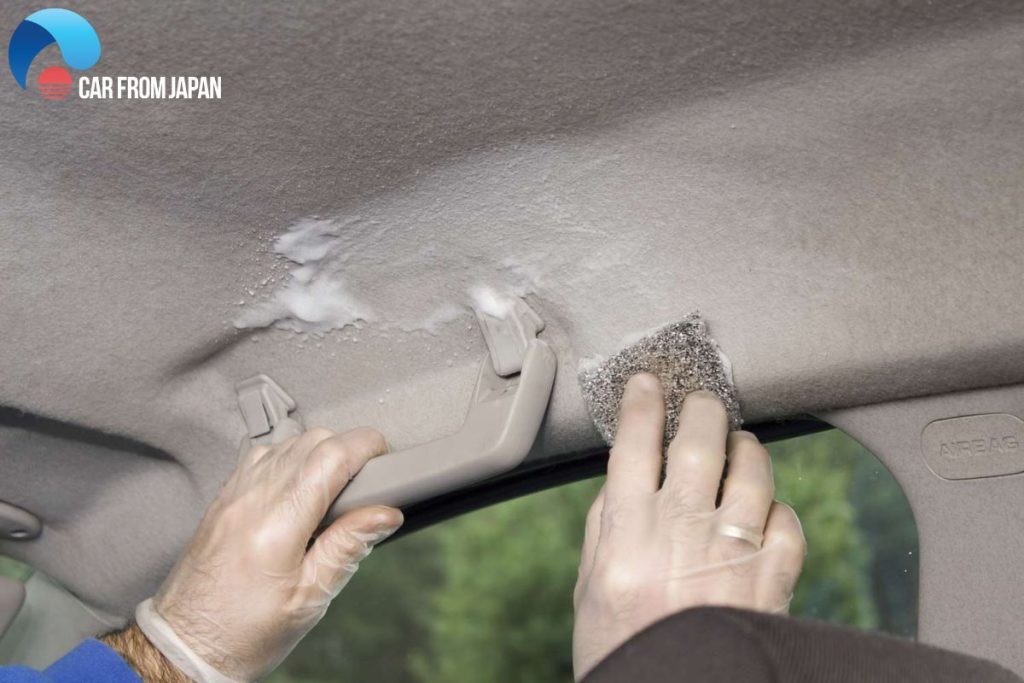A drooping car headliner isn’t just an eyesore; it can detract from your driving comfort and even indicate underlying issues within your vehicle. If you’re noticing the fabric above you starting to sag, don’t worry! You don’t necessarily need a costly professional replacement. This guide will walk you through effective and budget-friendly methods on how to repair car liner – or more specifically, your car’s headliner – without the hassle of complete removal. Let’s get started and restore your car’s interior to its former glory!
Understanding Your Car Headliner
Before diving into repairs, let’s understand what a headliner is and why it’s important. The headliner is the fabric material lining your car’s roof interior. It’s attached to the roof frame and serves several crucial functions. Firstly, it provides a finished, aesthetically pleasing look to the cabin. Secondly, it acts as a sound insulator, reducing road noise and vibrations for a quieter ride. Finally, it provides thermal insulation, helping to regulate the temperature inside your car by buffering against external heat and cold.
Typically, a car headliner is constructed from multiple layers. This often includes a foam backing, commonly made of polyurethane, which is bonded to a rigid headliner board. This board is then secured to the car’s roof. The foam layer is key for both comfort and insulation. Without the headliner, your car’s interior would be more susceptible to temperature fluctuations and external noise, particularly at higher speeds. Moreover, the headliner plays a role in the acoustics of your car’s audio system, contributing to optimal sound quality within the cabin.
Common Causes of Car Headliner Sagging
Over time, car headliners can begin to sag, becoming detached from the backing board. This is a common issue, particularly in older vehicles or those exposed to harsh conditions. Understanding the reasons behind a sagging headliner is the first step in addressing the problem effectively. Several factors contribute to this issue:
Heat and Sunlight: Excessive heat, especially prolonged exposure to direct sunlight, is a primary culprit. The adhesive used to bond the headliner fabric to the backing board is susceptible to heat degradation. High temperatures can cause this glue to weaken and eventually fail, leading to the fabric detaching and sagging.
Moisture and Humidity: Moisture is another significant factor. Humidity, leaks from sunroofs or windows, or condensation can penetrate the headliner. The foam backing material is absorbent, and when it soaks up moisture, it can lose its structural integrity and shape. This moisture weakens the adhesive and contributes to warping and sagging of the headliner fabric.
Deterioration of Adhesive: Even without extreme heat or moisture, the adhesive itself can degrade over time. Like any material, the glue used in headliners has a lifespan. As it ages, it can become brittle and lose its bonding strength, resulting in headliner separation.
Poor Initial Installation: In some cases, a sagging headliner can be traced back to inadequate installation during manufacturing. Insufficient adhesive application or improper techniques during the initial headliner installation can lead to premature sagging.
Physical Stress: While less common, physical stress can also contribute. In vehicles with children or pets, accidental pulling or scratching at the headliner fabric can strain the adhesive and accelerate the sagging process.
DIY Methods: How to Repair Sagging Headliner Without Removal
Replacing the entire headliner can be a significant expense, especially for older cars. Fortunately, there are several effective DIY methods to repair a sagging headliner without the need for complete removal, saving you both time and money. These techniques are particularly useful for addressing common sagging issues and restoring the appearance of your car’s interior.
1. Re-gluing with Headliner Adhesive
For minor sagging, especially around edges or corners, re-gluing is a straightforward and effective solution. This method works best when the fabric is only partially detached. It’s crucial to use a specialized headliner adhesive, as regular glues may not withstand the temperature fluctuations inside a car or provide a strong enough bond for fabric. Spray-on headliner adhesives are ideal as they offer even application and are easy to use.
Steps for Re-gluing:
- Preparation: Clean the sagging area of the headliner and the exposed backing board. Remove any loose foam or old adhesive. Use a soft brush or vacuum cleaner for this.
- Apply Adhesive: Shake the spray adhesive can well. Apply an even coat of adhesive to both the back of the sagging fabric and the corresponding area on the headliner board. Follow the adhesive manufacturer’s instructions regarding drying time. Typically, you’ll need to let the adhesive become tacky before pressing the fabric back into place.
- Reattach Fabric: Carefully align the fabric and gently press it back onto the headliner board. Work from the center outwards to avoid trapping air bubbles or creating wrinkles. Use a clean cloth or a small roller to apply even pressure and ensure a strong bond.
- Curing Time: Allow the adhesive to cure completely according to the product instructions. Avoid touching or disturbing the repaired area during this time.
2. Using Twist Pins (Saggy Stoppers)
For more extensive sagging, or when adhesive alone isn’t sufficient, twist pins, often called “saggy stoppers,” offer a simple and inexpensive mechanical solution. These clear-headed pins are designed to secure the fabric back to the headliner board without causing significant damage.
Steps for Using Twist Pins:
- Identify Sagging Areas: Determine the areas where the headliner is sagging most noticeably.
- Pin Placement: Starting at the most sagged point, gently push the pin through the fabric and into the foam backing board.
- Twist and Secure: Twist the pin head to secure it in place. The clear head of the pin makes it relatively inconspicuous against most headliner fabrics.
- Pattern and Distribution: Distribute the pins evenly across the sagging areas. You can arrange them in a pattern for a more visually appealing result. Use enough pins to hold the fabric firmly against the board, but avoid over-pinning.
3. Headliner Pins (Sequin Pins)
Similar to twist pins, sequin pins provide another pinning option. These are fine, sharp pins that can be pushed through the headliner fabric and into the backing board. They are a budget-friendly and quick fix for sagging, especially for larger areas.
Steps for Using Headliner Pins:
- Gather Pins: Obtain a sufficient quantity of sequin pins. Choose pins with heads that are a similar color to your headliner for better concealment.
- Pinning Technique: Push the pins through the fabric into the foam backing board. Ensure the pins go in straight to avoid bending or breaking.
- Spacing and Pattern: Space the pins strategically across the sagging area, typically a few inches apart. You can create patterns or lines with the pins for a neater appearance.
- Check Security: Ensure the pins are firmly in place and holding the fabric taut against the board.
4. Steam Cleaner and Paint Roller Method
For headliners sagging around the edges, the steam cleaner and paint roller combo can be surprisingly effective. The steam gently reactivates the old adhesive, while the paint roller helps to smooth and re-adhere the fabric.
Steps for Steam and Roller Method:
- Steam Application: Use a car steam cleaner to gently apply steam to the sagging edges of the headliner. Keep the steam nozzle moving and avoid concentrating steam in one spot for too long to prevent damage. The steam will help to soften and reactivate the old glue.
- Rolling and Smoothing: Immediately after steaming an area, use a clean paint roller to gently roll over the fabric, pressing it back against the headliner board. Work in sections, steaming and rolling gradually around the edges.
- Even Pressure: Apply even pressure with the roller to ensure the fabric adheres smoothly without creases or wrinkles.
- Drying Time: Allow the repaired area to dry completely. Avoid touching or disturbing the headliner until it’s dry.
https://www.youtube.com/embed/uD0-v5C5Jyk[/embed]
A YouTube video demonstrating truck, car, and van headliner repair tips and tricks, providing visual guidance on DIY headliner restoration methods.
Preventing Future Headliner Sagging
Once you’ve repaired your sagging headliner, taking preventative measures can help extend its lifespan and avoid future issues. While some factors are unavoidable, proactive care can significantly reduce the likelihood of premature sagging.
Preventative Tips:
- Park in Shade: Whenever possible, park your vehicle in shaded areas or garages, especially during hot and sunny weather. This minimizes heat buildup inside the car and reduces stress on the headliner adhesive.
- Window Tinting: Consider installing window tinting. Tinted windows reduce the amount of solar heat entering your car, helping to keep the interior cooler and protect the headliner.
- Regular Seal Checks: Inspect your car’s window and sunroof seals regularly. Ensure they are in good condition and prevent water leaks into the car’s interior, which can damage the headliner.
- Gentle Cleaning: When cleaning your car’s interior, be gentle around the headliner. Avoid harsh chemicals or excessive moisture. Lightly vacuuming with a soft brush attachment is usually sufficient for cleaning the headliner.
- Avoid Extreme Interior Heat: Try to avoid prolonged exposure to extreme interior heat. On hot days, use sunshades when parking outdoors to minimize heat buildup.
- Limit Physical Stress: Discourage children and pets from pulling or scratching at the headliner fabric.
Headliner Replacement Costs: When DIY Isn’t Enough
While DIY methods are effective for many sagging headliner issues, sometimes the damage is too extensive, or you may prefer a professional solution. Headliner replacement involves removing the old headliner, preparing the headliner board, and installing a new fabric. The cost of headliner replacement varies depending on your car model, the type of fabric, and labor rates.
Estimated Replacement Costs:
| Vehicle Type & Example Models | Estimated Cost Range |
|---|---|
| Sedan/Hatchback/Coupe (Simple Design) e.g., Honda Accord, Toyota Corolla | $300 – $750 |
| SUV/Crossover (Sunroof/Moonroof) e.g., Toyota RAV4, Nissan X-Trail | $500 – $900 |
| Luxury Vehicle (Complex Design, High-Quality Materials) e.g., BMW, Mercedes-Benz | $1,000 – $6,000+ |


These are average estimates. Luxury vehicles or those with complex headliner designs and numerous accessories (like sunroofs, lighting, or sensors) will generally have higher replacement costs. Obtaining quotes from local auto upholstery shops will provide a more accurate cost estimate for your specific vehicle.
Conclusion
A sagging car headliner, while often a cosmetic issue, can detract from your car’s overall appeal and comfort. Fortunately, with these DIY methods for how to repair car liner, you can effectively address sagging without the expense of full replacement. Whether you choose re-gluing, pins, or the steam cleaner method, these techniques offer budget-friendly solutions to restore your car’s interior. However, remember preventative care to prolong the life of your headliner. If DIY isn’t for you, professional headliner replacement remains an option to bring your car’s interior back to its best.
Frequently Asked Questions (FAQs)
How do I know if my ceiling is sagging (headliner)?
Signs of a sagging headliner include:
- Visible Drooping: The fabric is visibly hanging down or detached from the roof.
- Cracking Sounds: You may hear cracking or rustling sounds from the headliner area, especially when the car moves or doors are closed.
- Loose Fabric: Touching the headliner reveals loose or detached fabric.
- Blisters or Bubbles: In some cases, you might see small bubbles or blisters forming on the headliner surface before it starts to sag significantly.
Is it okay to fix the headliner sagging myself?
Yes, for many common sagging issues, DIY repair is perfectly acceptable and can save you a significant amount of money. DIY methods like re-gluing, pinning, or using steam are effective for minor to moderate sagging. Headliner repair kits are also readily available online and at auto parts stores, providing tools and materials for DIY fixes.
Can I paint a headliner to repair it?
While technically possible, painting a headliner is generally not recommended as a repair method for sagging. Paint can make the fabric stiff, alter its texture, and may not adhere well long-term due to temperature changes inside the car. Furthermore, painting won’t fix the underlying issue of adhesive failure causing the sag. It’s typically better to address the sagging with adhesive or pinning methods or replace the headliner fabric entirely if needed.
Does car insurance cover car headliner replacement?
Generally, no, standard car insurance policies typically do not cover headliner replacement due to wear and tear, age, or sagging. Car insurance is primarily designed to cover damages from accidents, collisions, or specific covered perils like theft or vandalism. Wear and tear items like headliners are considered maintenance issues and are usually not covered by standard auto insurance policies. Extended warranties or specific interior protection plans might offer some coverage, but it’s best to review your policy details.

